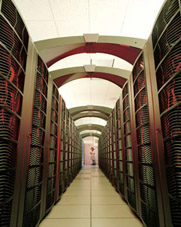1. DNA Synthesis
2. Computation & Bio-informatics
3. Nanopore
4. Robot
5. DNA Sequencing
6. Cell Growth
Molecular-scale engineering solutions in biology are impressive. Characterization of biological systems at the molecular level and extraction of essential information for engineering design is a computational challenge. High-performance computers must be viewed as essential components of any modern bio-informatics and molecular modeling attempts.
NASA computational resources and bio-informatics algorithms are used to support the optimization of oligonucleotide array design and molecular dynamic modeling of ion signatures in nanopores. The computational resources include Silicon Graphics (SGI) Origin (1024 CPUs and 512 CPUs, 32 CPUs clusters) and Altix (several 512 CPUs machines) systems. Additionally, researchers make use of SGI Octane dual and SGI Octane8-CPU machines as local workstations and personal computers (MS Windows PCs). These resources expedite the computational analysis of oligonucleotide probes, microarray design, and ion channel transport signatures from months to hours.
Molecular Dynamics (MD) simulations  use the following software packages: NAMD use the following software packages: NAMD  , AMBER , AMBER  , VMD , VMD  , GRID20 , GRID20  (developed at the Laboratory of Chemometrics,University of Perugia (developed at the Laboratory of Chemometrics,University of Perugia  ), Cerius2 ), Cerius2  , InsightII , InsightII  , CHARMM , CHARMM  (academic version).The Poisson-Nernst-Planck model is developed from an existing partial differential equation (PDE) solver, developed at NASA Ames Research Center (Deepak Bose (academic version).The Poisson-Nernst-Planck model is developed from an existing partial differential equation (PDE) solver, developed at NASA Ames Research Center (Deepak Bose  , T. R. Govindan). Complex bio-informatics algorithms are used for in-house developed custom software to support the optimization of oligonucleotide array design , T. R. Govindan). Complex bio-informatics algorithms are used for in-house developed custom software to support the optimization of oligonucleotide array design  . .
SGI Origin 3800 Parallel High-Performance Computer

| 
 Open the external link in a new window.
Open the external link in a new window.
 Show the picture in this window.
Show the picture in this window.